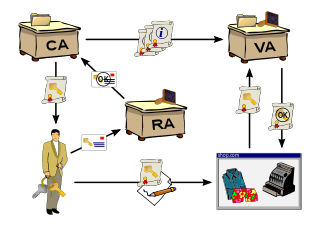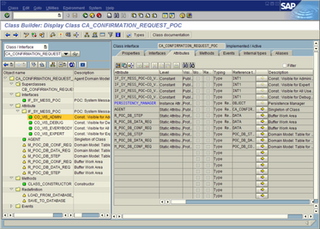
In computer networking, a proxy server is a server application that acts as an intermediary between a client requesting a resource and the server providing that resource. It improves privacy, security, and performance in the process.

A public key infrastructure (PKI) is a set of roles, policies, hardware, software and procedures needed to create, manage, distribute, use, store and revoke digital certificates and manage public-key encryption. The purpose of a PKI is to facilitate the secure electronic transfer of information for a range of network activities such as e-commerce, internet banking and confidential email. It is required for activities where simple passwords are an inadequate authentication method and more rigorous proof is required to confirm the identity of the parties involved in the communication and to validate the information being transferred.
SAP ASE (Adaptive Server Enterprise), originally known as Sybase SQL Server, and also commonly known as Sybase DB or Sybase ASE, is a relational model database server developed by Sybase Corporation, which later became part of SAP SE. ASE was developed for the Unix operating system, and is also available for Microsoft Windows.

Winlogon is the component of Microsoft Windows operating systems that is responsible for handling the secure attention sequence, loading the user profile on logon, creates the desktops for the window station, and optionally locking the computer when a screensaver is running. In Windows Vista and later operating systems, the roles and responsibilities of Winlogon have changed significantly.

SAP GUI is the graphical user interface client in SAP ERP's 3-tier architecture of database, application server and client. It is software that runs on a Microsoft Windows, Apple Macintosh or Unix desktop, and allows a user to access SAP functionality in SAP applications such as SAP ERP and SAP Business Information Warehouse (BW). It is used for remote access to the SAP central server in a company network.
As the next version of Windows NT after Windows 2000, as well as the successor to Windows Me, Windows XP introduced many new features but it also removed some others.
SAP NetWeaver Process Integration (SAP PI) is SAP's enterprise application integration (EAI) software, a component of the NetWeaver product group used to facilitate the exchange of information among a company's internal software and systems and those of external parties. Before the current version, SAP PI was called SAP Exchange Infrastructure (SAP XI). Like other NetWeaver components, SAP PI is compatible with software products of other companies.
The booting process of Windows NT is the process run to start Windows NT. The process has been changed between releases, with the biggest changes being made with Windows Vista. In versions before Vista, the booting process begins when the BIOS loads the Windows NT bootloader, NTLDR. Starting with Vista, the booting process begins with either the BIOS or UEFI load the Windows Boot Manager, which replaces NTLDR as the bootloader. Next, the bootloader starts the kernel, which starts the session manager, which begins the login process. Once the user is logged in, File Explorer, the graphical user interface used by Windows NT, is started.
SAP NetWeaver Application Server or SAP Web Application Server is a component of SAP NetWeaver which works as a web application server for SAP products. All ABAP application servers including the message server represent the application layer of the multitier architecture of an ABAP-based SAP system. These application servers execute ABAP applications and communicate with the presentation components, the database, and also with each other, using the message server.
There are a number of security and safety features new to Windows Vista, most of which are not available in any prior Microsoft Windows operating system release.
SAP SQL Anywhere is a proprietary relational database management system (RDBMS) product from SAP. SQL Anywhere was known as Sybase SQL Anywhere prior to the acquisition of Sybase by SAP.
SAP NetWeaver Portal is one of the building blocks in the SAP NetWeaver architecture. With a Web Browser, users can begin work once they have been authenticated in the portal which offers a single point of access to information, enterprise applications, and services both inside and outside an organization. The portal provides access to business processes and information, social collaboration and content management across various consumption channels.
In computer systems, an access token contains the security credentials for a login session and identifies the user, the user's groups, the user's privileges, and, in some cases, a particular application. In some instances, one may be asked to enter an access token rather than the usual password.
Microsoft SQL Server is a proprietary relational database management system developed by Microsoft. As a database server, it is a software product with the primary function of storing and retrieving data as requested by other software applications—which may run either on the same computer or on another computer across a network. Microsoft markets at least a dozen different editions of Microsoft SQL Server, aimed at different audiences and for workloads ranging from small single-machine applications to large Internet-facing applications with many concurrent users.
SAP Logon Tickets represent user credentials in SAP systems. When enabled, users can access multiple SAP applications and services through SAP GUI and web browsers without further username and password inputs from the user. SAP Logon Tickets can also be a vehicle for enabling single sign-on across SAP boundaries; in some cases, logon tickets can be used to authenticate into 3rd party applications such as Microsoft-based web applications.
In computer security, pass the hash is a hacking technique that allows an attacker to authenticate to a remote server or service by using the underlying NTLM or LanMan hash of a user's password, instead of requiring the associated plaintext password as is normally the case. It replaces the need for stealing the plaintext password to gain access with stealing the hash.
Pluggable Authentication Services (PAS) allows a SAP user to be authenticated outside of SAP. When the user is authenticated by an external service, the PAS will issue an SAP Logon Ticket or x.509 Certificate which will be used for future authentication into SAP systems. The PAS is generally regarded as an opportunity for companies to either use a new external authentication system or an existing external authentication system. In some cases, the PAS is used with an external single sign-on system that uses SAP Logon Tickets or x.509 certificates.
SafePeak Technologies is a software company founded in 2007 in Israel. It markets products for big data related to relational database management systems.

SAP HANA is an in-memory, column-oriented, relational database management system developed and marketed by SAP SE. Its primary function as the software running a database server is to store and retrieve data as requested by the applications. In addition, it performs advanced analytics and includes extract, transform, load (ETL) capabilities as well as an application server.
JEUS is a Korean Web application server which is developed by TmaxSoft. JEUS provides the web application server component of TmaxSoft's middleware-tier framework solution. It has been widely adopted in Korea where it holds the largest (42.1%) share of the market.




